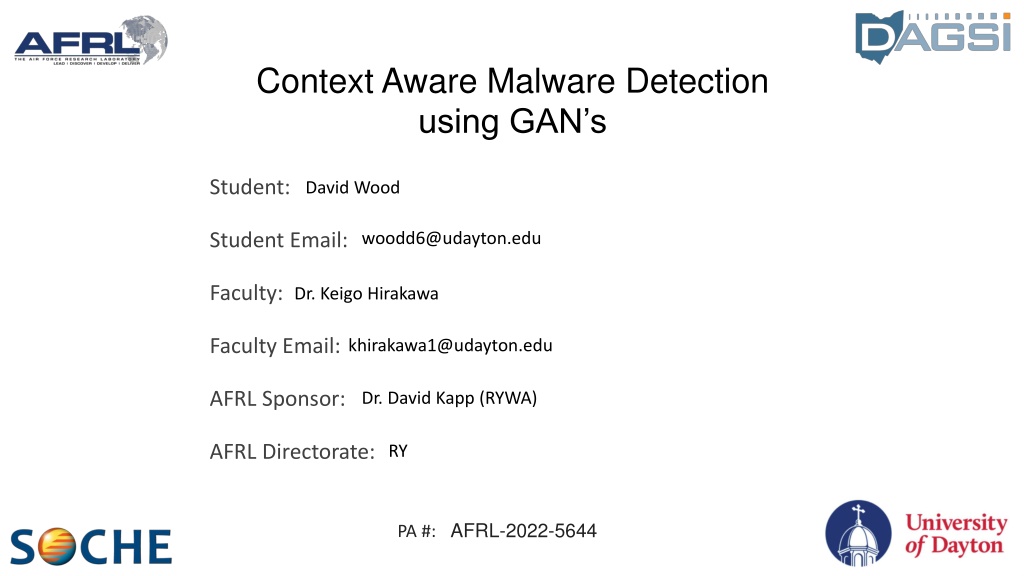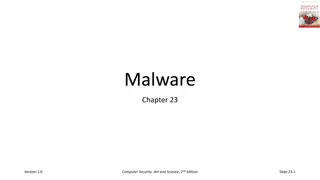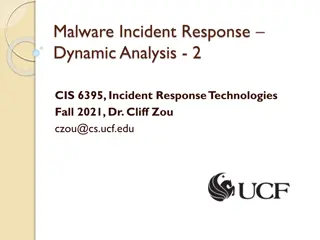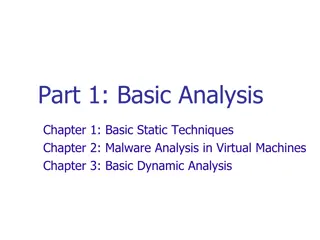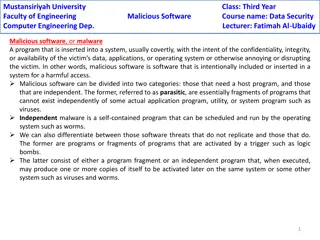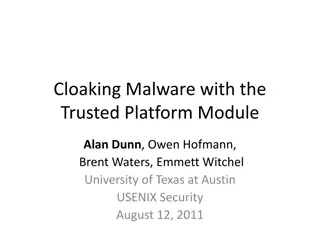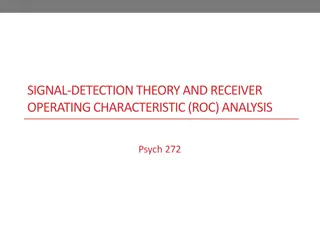Context-Aware Malware Detection Using GANs in Signal Systems
This project focuses on detecting malware within signal/sensor systems using a Generative Adversarial Network (GAN) approach. By training on normal system behavior and generating fake malware-like samples, the system can effectively identify anomalies without relying on signature-based methods. The GAN framework helps in clustering normal behavior, detecting compromised systems, and reducing false positives, ultimately enhancing the security of signal systems against novel trojan malware.
Download Presentation

Please find below an Image/Link to download the presentation.
The content on the website is provided AS IS for your information and personal use only. It may not be sold, licensed, or shared on other websites without obtaining consent from the author. Download presentation by click this link. If you encounter any issues during the download, it is possible that the publisher has removed the file from their server.
E N D
Presentation Transcript
Context Aware Malware Detection using GAN s Student: David Wood Student Email: woodd6@udayton.edu Faculty: Dr. Keigo Hirakawa Faculty Email: khirakawa1@udayton.edu AFRL Sponsor: Dr. David Kapp (RYWA) AFRL Directorate: RY PA #: AFRL-2022-5644
Problem Statement Identification of malware within the supply chain of a signal/sensor system. 1) 2) Goal: Design a binary classifier to detect malware from system behavior (Context) Challenges: We want to be prepared for detecting novel trojan malware. Signature based malware detection will fail. Approach: Anomaly detection (without malware signatures) Use limited examples of valid system data Use GAN to promote the clustering of the normal system behavior in feature space. 3)
Binary Classifier (Signature-Based) Train on only compromised system behaviors Pros Can cluster known malware Cons Does not cluster unknown malware False Negatives (FN) can be high. Does not cluster normal system behavior False Positives (FP) from misclassification of System Train on the normal and compromised system behaviors Pros Can cluster the normal system and known malware Cons Does not cluster unknown malware False Negatives (FN) can be high.
Our Goal: Anomaly Detection Trains on normal system behavior Pros Can still detect unknown malware Clusters the normal system behavior Low false positives (FP) Cons Does not cluster unknown malware False negatives, maliciousness low In signal systems Small perturbations can be thought of as noise Large perturbations are attacks with consequence.
Our Solution: Generative Adversarial Network (GAN) Generator (Proxy Malware) Is used to produce fakes that alters the system behavior: Yg =gen(X,Ys). Wants to produce fakes that behave like malware, in the form of hiding, so it s given input/output of the real system. Discriminator Learns to detect fake samples from real samples. Forces the generator to continue to produce fakes close to the real system or they will be detected. Eventually the fake and real samples will be so similar that the impact of the fakes would be negligible to the the real performance. Is now trained as a detector. Impact: The discriminator has more samples to learn the possible feature space of the normal system and detect compromised systems, and anomalies.
Our Solution: Generative Adversarial Network (GAN) To promote clustering... Generator designed to learn the classification boundary Discriminator learns to classify normal system and generator behavior The classification boundary will tighten over time. In signal Systems The Trojan is ineffective outside the classification boundary The Trojan is ineffective at center of the cluster The Trojan is most effective just inside the classification boundary (maximize attack while hiding) The generator is mimicking ideal Trojan attack
VirusShare Dataset VirusShare Dynamic malware dataset provided by UCI Machine Learning Repository Dynamic features of VirusShare Executables Data Set Malicious executables ran on Cuckoo Sandbox for 1 min, recording all system calls. Each sample is provided with a maliciousness score from the Cuckoo Sandbox Score[1] 107888 samples, with a maliciousnessscore of 0.0 to 1.0, 482 measurements (measured occurrences of system calls) per sample Counts Measurements Plot showing the performance of the generator successfully learning the Normal System Features. The 482 measurements are what the generator will train on, trying to recreate similar samples and calls that happen for that sample group. [1] Huynh, Ngoc Anh, Wee Keong Ng, and Kanishka Ariyapala. "A new adaptive learning algorithm and its application to online malware detection." International Conference on Discovery Science. Springer, Cham, 2017.
Designing the Experiment Normal System (Proxy) VirusShare lacks a clean dataset of calls made in a 1 min interval without any malware being run. Low maliciousness (blue) will be treated as a normal system proxy with maliciousness scores ranging from 0 to .25. This group will be split into a training set and a test set. The training set is the set the generator will try to mimic. Compromised System For the first test set, only high malicious samples will be used to test the model with scores from 0.75 to 1.0 Histogram showing the distributions of samples from the the VirusShare dataset, based on their maliciousness scores.
True Neg Discriminator Performance Validation was done by taking 1000 samples from the normal system group, and 1000 samples from the malicious system group and using the Discriminator model to predict their labels. True Pos False Neg Score vs Maliciousness As predicted the model did very well at detecting malicious malware and labeling it as outside of the group (0). The testing set was almost entirely classified as part of the system set, with a few false positive (0 instead of 1) ROC Curve The AUC of the ROC plot was .993 meaning that the model was almost completely successful in classifying every label correctly.
Conclusion Contributions Proposed Minimax GAN The generator as a proxy for malware, trains to find the boundary. The discriminator is our anomaly detector. Trains only on normal system behavior. Verified the Minimax GAN using real world malware data. Can detect unknown malware. Corresponds well to maliciousness score. This is a more resilient method for defending against new and unknown malware attacks. Future Work Optimized network architecture. Provide interpretability to the discriminator. Work to study different sets of malware data, with benign system signal data.
